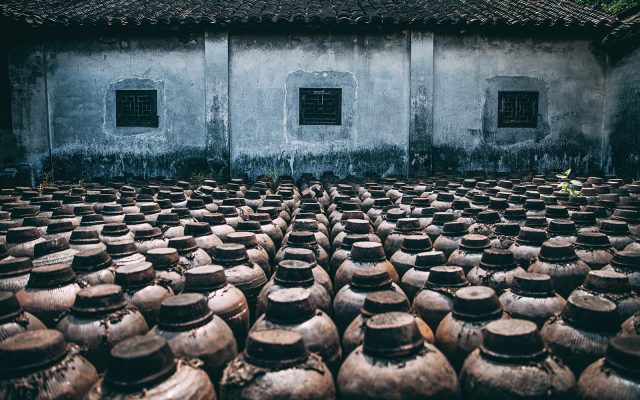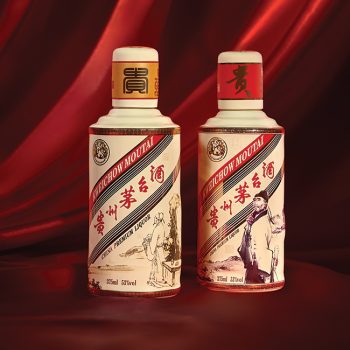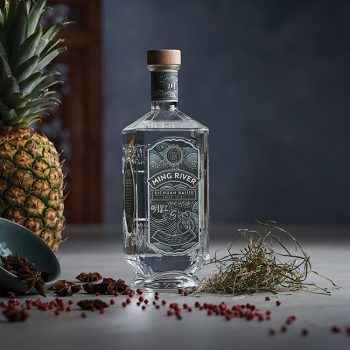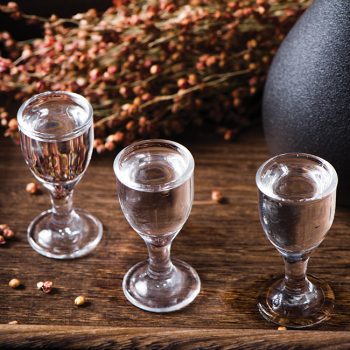Why baijiu is down – but not out
A number of headwinds have caused a downturn in baijiu sales in the spirit’s homeland, China. But brands are targeting younger drinkers, as well as overseas territories where there is a lot of potential for growth.

*This feature was originally published in the May 2024 issue of The Spirits Business magazine.
China’s national spirit, baijiu, has long held a grip on the nation and is a stalwart of banquets and dinner tables. According to IWSR Drinks Market Analysis, baijiu accounts for more than 95% of spirits consumption in its home country. But its dominant position in the market has been threatened in recent years by the Covid-19 pandemic, and by stricter government rules.
Data from IWSR showed baijiu sales declined by a compound annual growth rate (CAGR) of 10% between 2017 and 2022, with a 4% drop predicted for 2022-2027. In 2022, China’s alcohol market likely saw its ‘most challenging year of the past decade’, following renewed lockdowns and consumer caution, IWSR noted. Data from the analyst also revealed that spirits volumes fell by 17% in China in 2022, with a 4% drop expected in the five years to 2027, entirely due to the performance of Chinese baijiu, IWSR believes.
Excluding the Chinese spirit, all other major categories – whisky, gin, vodka, agave spirits, rum and brandy – are forecast to grow sales volumes by single-digit CAGRs (2022-2027).
Higher-quality baijiu
Shirley Zhu, research director – Greater China, IWSR, explains the decline: “The category is now premiumising, as rising incomes allow people to trade up to higher-quality baijiu. The lowest price segment of baijiu, consisting of unbranded baijiu consumed rurally, is now declining rapidly as tougher government regulation and increased consumer education push producers towards higher-quality brands. As a result, manufacturers have had to upgrade their products, and some ceased production of low-end brands.”
She also notes that the impact of Covid-19 and implementation of government regulations “accelerated the structural decline of baijiu, which has had the biggest impact on the low-priced segment”.
Zhu explains the impact of new rules: “In June 2022, the new national standard came into force. It gives a more detailed and accurate definition of baijiu, which excludes flavoured liquors that were sold as baijiu.”
Despite declines for the category as a whole, Zhu notes the ultra-premium-and-above baijiu segment is seeing growth. From 2017 to 2022, the subcategory saw CAGR growth of 12%, compared with a 13% decline for standard-and-below over the same period. IWSR expects the ultra-premium segment to rise by 7% between 2022 and 2027, while standard-and-below is forecast to drop by 7% in the five-year timeframe. Zhu says one of the challenges facing the category is its ability to appeal to a wider demographic. “The core consumer is male and aged over 40; baijiu has an old-fashioned image among many younger legal-drinking-age consumers, though some of the more innovative producers are trying to break the mould and reinvent baijiu for Millennials.”

Zhu says some baijiu companies, such as Kweichow Moutai, are attracting younger consumers by becoming “increasingly involved in digital marketing, and launching crossover food products such as baijiu-filled chocolates and ice cream, which are highly associated with a low-tempo lifestyle, and usually completely unrelated to baijiu”.
Bel Sun, general manager of Camus’ baijiu portfolio, Spirit of China, which distributes Kweichow Moutai in global travel retail, notes the amount of baijiu exported internationally is very small. She says baijiu brands are still attempting to attract younger consumers because the category is often consumed by an older generation, noting that a lot of brands plan activations to target younger drinkers.
 Derek Sandhaus, founder of Ming River baijiu, and author of Baijiu: The Essential Guide to Chinese Spirits, has seen a move towards premiumisation in baijiu. “There was a lot of bad baijiu on the market around 2010, a lot of distilleries producing it at different price points. Now people are focusing on the mid- to premium level,” he explains. “What I hear from the distilleries is not that the market is worse than it was when they were making twice as much baijiu, but that they’re making more profit at the moment. They’re producing less but earning more.”
Derek Sandhaus, founder of Ming River baijiu, and author of Baijiu: The Essential Guide to Chinese Spirits, has seen a move towards premiumisation in baijiu. “There was a lot of bad baijiu on the market around 2010, a lot of distilleries producing it at different price points. Now people are focusing on the mid- to premium level,” he explains. “What I hear from the distilleries is not that the market is worse than it was when they were making twice as much baijiu, but that they’re making more profit at the moment. They’re producing less but earning more.”
Like Sandhaus, Camus’ Sun says the category was damaged by low-quality baijius hitting the market.
Sandhaus also explains that president Xi Jinping’s cut on budgets for banqueting affected baijiu sales. “One of the big changes is the Chinese government used to buy a lot of baijiu directly from distilleries to serve at functions, but when the current president came to power [in 2013], one of the first things he said was that they weren’t going to spend their own resources on baijiu any more. That was a big shock to the industry. At least for a year or two, the market significantly declined.
“In the long term it’s a huge benefit to the baijiu industry but it’s no longer subsidised in the same way it was before; they’re actually competing to make the best products and get the pricing right. In the long-term it’s good for the industry, but at the same time it’s diminished the amount of baijiu in terms of volume that they’re producing.”

More widely, Asian spirits have been spotlighted as consumer trends by UK retailers The Whisky Exchange and Master of Malt. Dawn Davies, buying director for The Whisky Exchange and its supply arm, Speciality Drinks, says Asian spirits, including baijiu, awamori and whiskies, are gaining prominence on the global stage.
The Whisky Exchange reported approximate growth of 14% for Asian spirits in the past year, with a 5% gain for baijiu.
Davies says Asian spirits are gaining much more interest, with consumers seeking them out in stores. The retailer is “actively looking” to take on more baijiu, sake and shochu.
She has also spotted an “opportunity in Asian whiskies that aren’t Japanese” and says the Chinese consumer is “hugely loyal to brand China”.
Davies believes the emergence of new Chinese whisky is “where the baijiu market will suffer”. In recent years, international spirits conglomerates, including Diageo and Pernod Ricard, have set up whisky distilleries in China, with Pernod recently unveiling the first whisky from its US$150 million Emeishan distillery. At the end of last year, Angus Dundee Distillers revealed plans to build a malt whisky distillery in Chun’an, China, along with a visitor experience.
Meanwhile, in summer 2023, The Whisky Exchange offered the first Chinese whiskies to be made available outside of the country to the UK. The whiskies, created by Goalong Distillery, sit at an affordable price point, says Davies. Goalong 5 Years Old Bourbon & Brandy Cask Single Malt Chinese Whiskey is priced at RRP £59.95/US$78, Goalong 5 Years Old Bourbon Cask Single Malt Chinese Whiskey costs £52.95/US$68, and Goalong Blended Chinese Whiskey costs £37.75/US$48.25.
New Chinese distillery
Cognac house Camus is also working on a new whisky distillery in China, in partnership with the fourth-biggest baijiu brand in the world, Gujinggong. The Guqi distillery, located adjacent to Gujinggong’s distillery in Bozhou, will combine Cognac-making techniques with fermentation methods used in baijiu production to create the “world’s most aromatic whiskies”. The site will use local barrels made from Chinese oak, pot stills from Scotland, and follow the same regulations used to make Scotch whisky.
Ryan Camus, business development director for new brands, affirmed that whisky will be second to baijiu, despite the latter’s decline. “People will still look for Scotch and Japanese; I don’t think Chinese whisky will be able to compete. The cost of procuring whisky in China is quite high.”
With waning interest in baijiu among local consumers, could international markets be a way for brands to win over more curious drinkers willing to explore new categories? “For baijiu to have a healthy future, it needs to have a broader consumer base than it does have in China,” says Sandhaus, who launched Ming River with the aim of taking baijiu to global markets.
Sandhaus notes most baijiu brands export their flagship products to enable “wealthy business people to buy them while overseas”, rather than to make it popular outside of China.
 Overseas markets
Overseas markets
In 2020, Ming River signed a US import and sales agreement with 375 Park Avenue Spirits, a division of the Sazerac Co. Today, the brand is available in 15 countries, with 75% of sales coming from the US. Germany and the UK are also important markets for Ming River, Sandhaus says, with the brand listed on The Whisky Exchange.
“The US is the biggest market outside of Asia for baijiu consumption, and baijiu is expected to see growth there, though from a small base,” says IWSR’s Zhu.
“In Asia, growth is expected in countries like South Korea and Japan. American consumers are unfamiliar with the category, and the drink’s taste profile is quite different from the spirits they are accustomed to.
“Traditional baijiu is not easily mixed in cocktails; it is usually consumed as shots during dinner.
“To drive further expansion in the US, baijiu would require strategic involvement from major Chinese producers, as well as promotion and support from top on-premise Pan-Asian accounts in the US.”
What trends are you seeing in Asian spirits globally?
Ryan McFarland – chief commercial and strategy officer, Drinksology Kirker Greer
“Our insight tells us that consumers have a real joy in discovering new tastes and experiences. Global influences, especially Asian and far eastern flavours that are also authentic, are increasingly important. Additionally, consumers are looking to find out more about the less well-known aspects of culture, for example looking closer into how indigenous ingredients and botanicals are produced. Asian spirits have seen a global surge in popularity and as a result savoury twists are in, with bartenders incorporating ingredients like miso and mushrooms for a unique umami experience.”
Related news
Mataroa Gin features at Roma Bar Show
